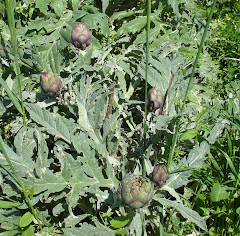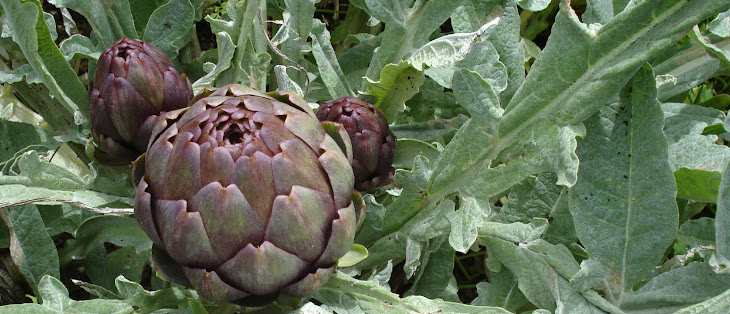As one of our neighbours said the other day as she walked past on the way to her garden,
Friday, 30 May 2008
Paradise
Monday, 26 May 2008
Irrigation


 so our concerns about keeping the garden well watered over the summer seem like a bit of a joke at the moment. But the hot dry weather will come and then the earth will need some help to conserve the water we give it, and we have to think about that now while we’re planting the beds.
so our concerns about keeping the garden well watered over the summer seem like a bit of a joke at the moment. But the hot dry weather will come and then the earth will need some help to conserve the water we give it, and we have to think about that now while we’re planting the beds.When we were in southern
Our neighbours’ gardens here in Gabian have similar ridges and channels, around their tomato beds especially. Last year we were advised by one of them that we were not watering the plants properly – they should be planted in a dip and watered through this depression underneath the leaves. Tomato leaves, we found, do not react well to having drops of water on them – they get dead spots on the leaves where the water has touched them. Having grown tomatoes only in the greenhouse when we lived in
 In our garden we’ve been trying to recreate the watering ideas we’ve seen, although on a smaller scale. Last year we bought a watering kit – some metres of hosepipe, connections and small sprinklers to be inserted in the pipe in the right place for each of the plants. We tried out enough to water one bed of tomatoes – about a dozen plants – and it worked well, that bed produced our best tomatoes. The slow drip of water from the sprinkler soaks in more effectively than a spray from a hose, and it’s good to be able to sit with a drink enjoying the view of the garden while the tomatoes are being watered! So this year we’ve decided to extend this system so that it will now cover the cucumbers and haricot beans, which are in last year’s tomato bed, and one of the beds of tomatoes – with about 20 plants and the cherry tomatoes.
In our garden we’ve been trying to recreate the watering ideas we’ve seen, although on a smaller scale. Last year we bought a watering kit – some metres of hosepipe, connections and small sprinklers to be inserted in the pipe in the right place for each of the plants. We tried out enough to water one bed of tomatoes – about a dozen plants – and it worked well, that bed produced our best tomatoes. The slow drip of water from the sprinkler soaks in more effectively than a spray from a hose, and it’s good to be able to sit with a drink enjoying the view of the garden while the tomatoes are being watered! So this year we’ve decided to extend this system so that it will now cover the cucumbers and haricot beans, which are in last year’s tomato bed, and one of the beds of tomatoes – with about 20 plants and the cherry tomatoes.For the aubergines, peppers and courgettes we’ve made irrigation channels along the centre of the beds or radiating out from the centre. So far we’ve found these channels need a lot of attention to keep the water running freely through them to the end of the row, but we’re hoping it will get easier to manage.
And now the passion flowers are out
Monday, 19 May 2008
Garrigue
The garrigue which covers most uncultivated areas of land around the

The word
Areas of garrigue symbolise these rocky hillsides so much that you might think they were natural but in fact they are the result of human activity over thousands of years. From the time of the earliest settlements around the
The result is a mix of plants, most of which are evergreen: holm oak (evergreen oak), olivettes (small wild olive trees), broom, arbutus, rosemary, thyme and other herbs, and a colourful display of flowers in spring from asphodel, orchids and numerous small plants which grow wherever they find space.

asphodel
Extensive fires have been in the news around the
Some other spring wild flowers:
 honeysuckle
honeysuckleThere is a good article in French about the garrigue here as well as other interesting nature articles about the Languedoc on the same website.
And a short article in English here on the history of the garrigue.

(this picture was taken at the end of November)
Thursday, 15 May 2008
Wednesday, 14 May 2008
Sustainable fish
Kate
Mussels and oysters from Bouzigues - again less than 40 km from here - are sustainable, so we can carry on eating those without guilty feelings.
Saturday, 10 May 2008
Beginning to win the battle with weeds

At last we seem to be catching up with the weeding after our holidays last month ... there's still a lot to do though.
 Another cistus flower, a white one, lasted just for the day as they all do.
Another cistus flower, a white one, lasted just for the day as they all do. Yes, I know I'm obsessed with artichokes, but I'm pleased with today's crop.
Yes, I know I'm obsessed with artichokes, but I'm pleased with today's crop.
Thursday, 8 May 2008
Planting summer
 The chard has had to go, the first sowing of peas too. They
The chard has had to go, the first sowing of peas too. They

We
This iris flower was opening as we ate our lunch in the garden today.

The lemon tree is covered in flower.

This cistus flower lasted a day ... it was there yesterday, petals like crumpled tissue paper, today the petals lay on the ground around the plant. There'll be more soon.






















